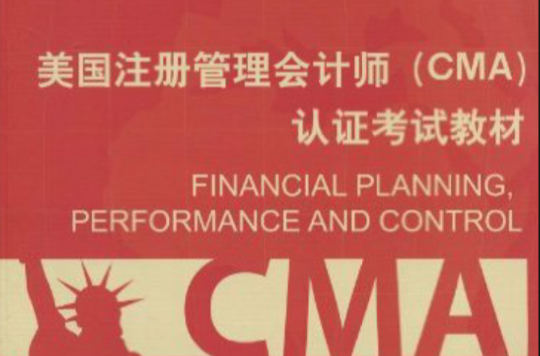《高才財經系列叢書·美國註冊管理會計師認證考試教材》是2010年1月1日上海交通大學出版社出版的圖書,作者是陳越
基本介紹
- 書名:高才財經系列叢書·美國註冊管理會計師認證考試教材
- 頁數:422
- 出版社:上海交通大學出版社
- 出版時間:2010年1月1日
- 裝幀:平裝
- 開本:16
圖書信息,作者簡介,內容簡介,媒體評論,目錄,
圖書信息
出版社: 上海交通大學出版社; 第1版 (2010年1月1日)
叢書名: 高才財經系列叢書
平裝: 422頁
正文語種: 簡體中文, 英語
開本: 16
ISBN: 9787313061553
條形碼: 9787313061553
尺寸: 26.8 x 20.4 x 3.2 cm
重量: 921 g
作者簡介
陳越,高才(中國)培訓總裁兼首席培訓師。
陳越先生目前是IMA協會唯一業裔董事,曾擔任美國多家公司高級財務分析師,取得多項財會類CPA,CMA,CFM,CIA,AIA,LIFA權威證書,同時有著豐富的授課經驗。
美國管理會計師協會董事會(Institute of Management Accountants)董事
同際金融協會(Institute of Research Associat ion)董事
美國註冊會計師協會會員(American Institute of Certifled Accountants)
美國內部審計師協會會員(Institute of Internal Auditors)
英國國際會計師協會會員(Association of International Accountants)
2006年1月擔任“哈佛上海論壇”財務部分
主講
登入2003年世界名人錄——“Who's Who”(財經類)並取得證書
登入2002年斯特莫北美名人錄——“Who's Who”(財經類)並取得證書
內容簡介
《美國註冊管理會計師(CMA)認證考試教材》內容簡介:近年來,越來越多的中國財經、金融、管理專業人士開始關注和參加美國註冊管理會計師考試。高才(中國)培訓致力研發國內首套美國CMA考試雙語教材,《美國註冊管理會計師(CMA)認證考試教材》在內容上除了包括所有美國CMA考試大綱規定考試範圍,更添加了許多中文背景注釋、高才培訓的提示和專業術語表,彌補了中國學員閱讀純英文CMA培訓教材所遇到的語言和文化差異障礙。
本系列叢書融合美國多所知名院校MBA課程內容設定,知識體系設定合理,內容翔實,理論聯繫實際,突出案例教學,深入淺出,易懂易學,並對所有概念的相關的考試掌握要求逐一做了圖案標識並提示了記憶技巧。適合所有美國CMA考生閱讀。
媒體評論
如果學習是一條船,順利通過考試是我想要登上的彼岸,那么高才(中國)培訓就是最強壯的划槳手,幫助我克服重重險難,送我登上了成功的彼岸。
——高才CMA上海面授班第十二二期學員 王麗麗
成為一個註冊管理會計師是我的夢想,高才(中國)培訓為了插上了飛翔的翅膀。高水準的服務,專業的講師團隊,更多貼心的增值服務,讓我僅花費了7個月的時間就圓滿了我的夢想。
——高才CMA上海面授班第九期學員 毛丹芸
我的感受是:高才(中國)培訓的教學服務非常完善和全面,為工作繁忙的我度身定製了我的專屬CNA學習計畫,使我超出預期完成了我的CMA學業。
——高才CMA第十期學員 董蓉蓉
我沒有財務背景,但對這個行業的興趣驅使我選擇了CMA。高才(中國)培訓優秀的老師們,孜孜不倦地對我這個零基礎學員給予悉心教導,讓我進入財務領域不再是遙不可及的夢想。
——高才CMA上海第十一期學員 黎淑瓊
目錄
Chapter One Planning, Budgeting and Forecasting (30%-Levels A, B, and C)
1.1 IMA LOS
1.2 Budgeting Preparation
1.2.1 Operations and Performance Goals
1.2.2 Characteristics of a Successful Budget Process
1.2.3 Management by Objective and Budgeting
1.3 Forecasting Techniques
1.3.1 Regression Analysis
1.3.2 Learning Curve Analysis
1.3.3 Exponential Smoothing
1.3.4 Time Series Analysis
1.3.5 Expected Value
1.4 Budgeting Mmethodologies
1.4.1 Annual Business Plans (Master Budgets)
1.4.2 Project Budgeting
1.4.3 Activity-based Budgeting
1.4.4 Zero-based Budgeting
1.4.5 Continuous (Roiling) Budgets
1.4.6 Flexible Budgeting
1.5 Annual Profit Plan and Supporting Schedules
1.5.1 Operational Budgets
1.5.2 Financial Budgets
1.5.3 Capital Budgets
1.6 Top-level Planning and Analysis
1.6.1 Pro forma Income
1.6.2 Cash Flow Projections
Chapter Two Performance Management (25%-Levels A, B, and C)
2.1 IMA LOS
2.2 Cost and Variance Measures
2.2.1 Comparison of Actual to Planned Results
2.2.2 Use of Static and Flexible Budgets to Analyze Performance
2.2.3 Management by Exception
2.2.4 Use of Standard Cost Systems
2.2.5 Analysis of Variation from Standard Cost Expectations
2.3 Responsibility Centers and Reporting Segments
2.3.1 Types of Responsibility Centers
2.3.2 Transfer Pricing
2.3.3 Reporting of Organizational Segments
2.4 Performance Measures
2.4.1 Product Profitability Analysis
2.4.2 Business Unit Profitability Analysis
2.4.3 Customer Profitability Analysis
2.4.4 Return on Investment
2.4.5 Residual Income
2.4.6 EVA (Supplemental Materials)
2.4.7 Investment Base Issues
2.4.8 Effect of International Operations
2.4.9 Critical Success Factors
2.4.10 Balanced Scorecard
Chapter Three Cost Management (25%-Levels A, B, and C)
3.1 IMA lOS
3.2 Measurement Concepts
3.2.1 Broad Cost Classifications
3.2.2 Cost Behavior and Cost Objects
3.2.3 Actual, Normal and Standard Costing
3.2.4 Absorption (Full) Costing
3.2.5 Variable (Direct) Costing
3.2.6 Absorption (Full) Vs. Variable (Direct) Costing
3.2.7 Joint and By-product Costing
3.3 Costing Systems
3.3.1 Job Order Costing
3.3.2 Process Costing
3.3.3 Activity-based Costing
3.3.4 Life-cycle Costing
3.4 Overhead Costs
3.4.1 Fixed and Variable Overhead Expenses
3.4.2 Overhead Cost Allocation Rate
3.4.3 Plant-wide Versus Departmental Overhead
3.5 Operational Efficiency
3.5.1 Just-in Time System
3.5.2 Material Requirements Planning (MRP)
3.5.3 Theory of Constraints and Throughput Costing
3.5.4 Capacity Management and Analysis/Capacity Planning
3.6 Business Process Performance
3.6.1 Value Chain Analysis
3.6.2 Value Engineering
3.6.3 Process Analysis
3.6.4 Benchmarking
3.6.5 Activity-based Management
3.6.6 Kaizen and The Continuous Improvement Concepts
3.6.7 Best Practice Analysis
3.6.8 The Concept of Quality
3.6.9 Cost of Quality Analysis
3.6.10 Total Quality Management
Chapter Four Internal Controls (15%-Levels A, B, and C)
4.1 IMA LOS
4.2 Risk Assessment, Controls, and Risk Management
4.2.1 Internal Control Structure and Management Philosophy
4.2.2 Internal Control Procedures
4.2.3 Internal Control Risk
4.2.4 Interpretive Guidance of the Sarbanes-Oxley Act of 2002
4.2.5 U.S. Foreign Corrupt Practices Act Internal Control Requirements
4.2.6 COSO Internal Control Framework
4.3 Internal Auditing
4.3.1 Roles and Nature of The Internal Audit Function
4.3.2 Types of Audits Conducted by Internal Auditors
4.3.3 Supplemental Readings-external Auditor
4.4 Systems Controls and Security Measures
4.4.1 General Information System Controls
4.4.2 General Accounting System Controls
4.4.3 Application and Transaction Controls
4.4.4 Network Controls
4.4.5 Flowcharting
4.4.6 Backup Controls
4.4.7 Disaster Recovery Procedures
Chapter Five Professional Ethics (5%-Levels A, B, and C)
5.1 IMA LOS
5.2 Ethical Considerations for Management Accounting and Financial Management Professionals
5.2.1 Provisions of IMA's "Statement of Ethical Professional Practice"
5.2.2 Evaluation and Resolution of Ethical Issues
5.2.3 Supplemental Readings
術語表
參考文獻

